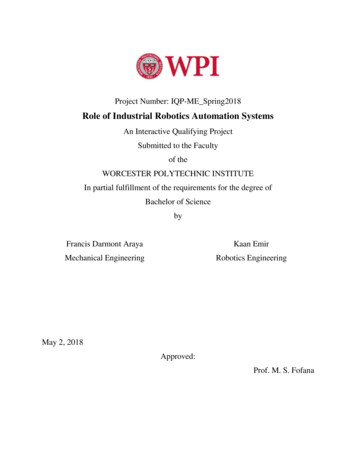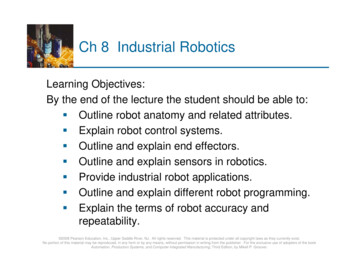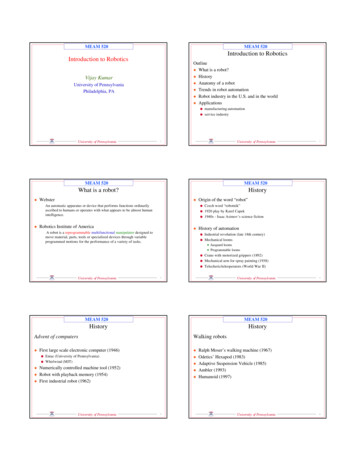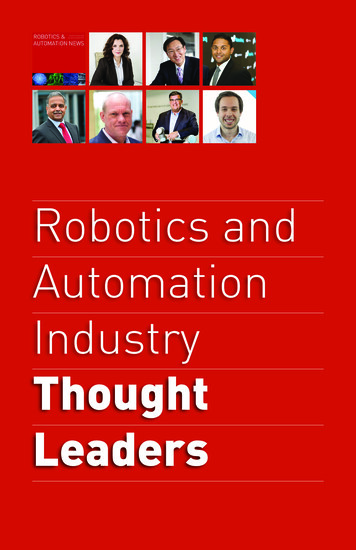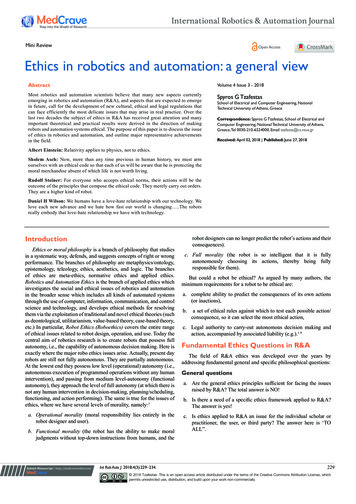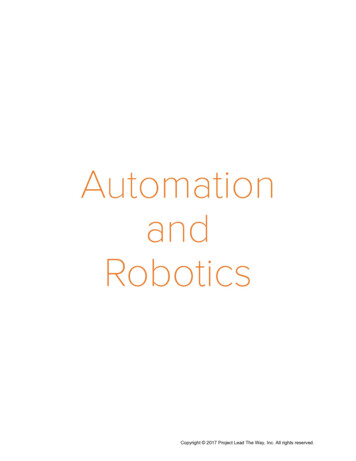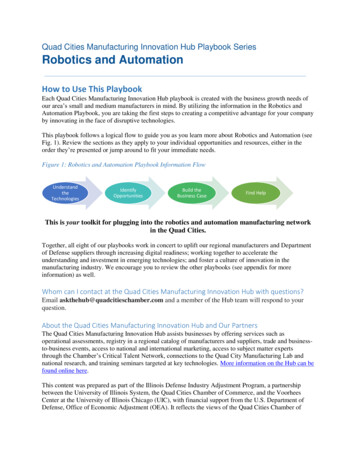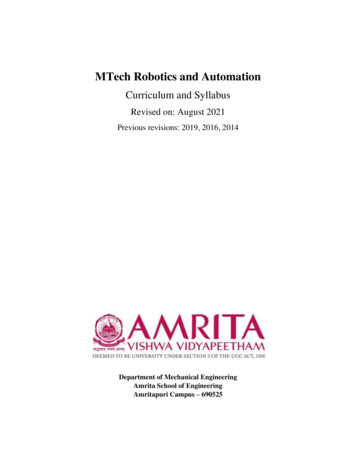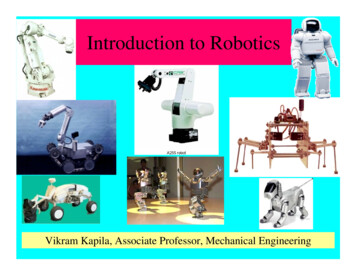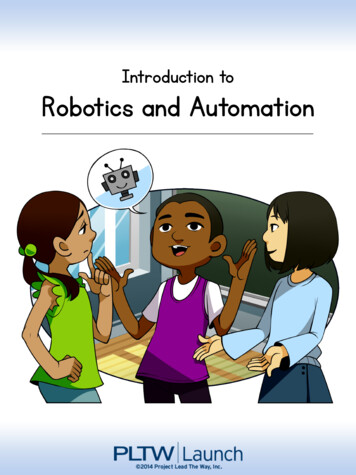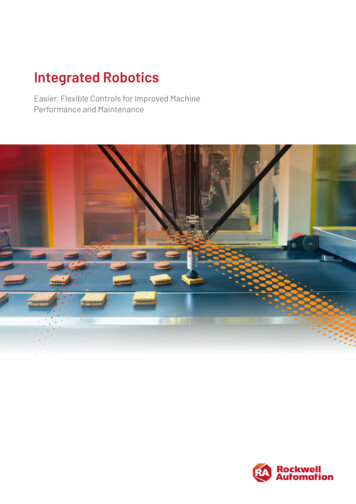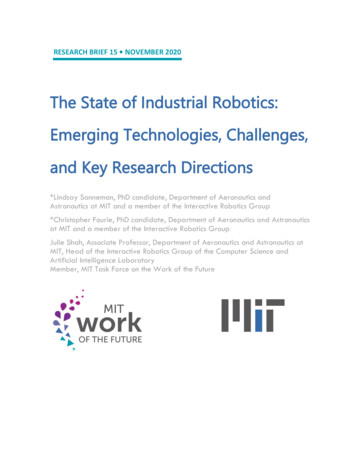
Transcription
RESEARCH BRIEF 15 NOVEMBER 2020The State of Industrial Robotics:Emerging Technologies, Challenges,and Key Research Directions*Lindsay Sanneman, PhD candidate, Department of Aeronautics andAstronautics at MIT and a member of the Interactive Robotics Group*Christopher Fourie, PhD candidate, Department of Aeronautics and Astronauticsat MIT and a member of the Interactive Robotics GroupJulie Shah, Associate Professor, Department of Aeronautics and Astronautics atMIT, Head of the Interactive Robotics Group of the Computer Science andArtificial Intelligence LaboratoryMember, MIT Task Force on the Work of the Future
The State of Industrial Robotics: EmergingTechnologies, Challenges, and Key ResearchDirectionsAuthors:*Lindsay Sanneman, PhD candidate in the Department of Aeronautics and Astronautics at MIT and amember of the Interactive Robotics Group lindsays@mit.edu*Christopher Fourie, PhD candidate in the Department of Aeronautics and Astronautics at MIT and amember of the Interactive Robotics Group ckfourie@mit.eduJulie Shah, Associate Professor in the Department of Aeronautics and Astronautics at MIT and head ofthe Interactive Robotics Group of the Computer Science and Artificial Intelligence Laboratoryjulie a shah@csail.mit.eduExecutive SummaryIn the past decade, European countries and companies—Germany and German companies, inparticular—have been working to gain a competitive advantage in manufacturing by integrating thelatest robots and related technologies into their manufacturing processes. For example, collaborativerobots (cobots) that can work more directly with workers—rather than being separated by cages forsafety reasons—offer a possible means to improve productivity without significantly loweringemployment. However, the success and extent of efforts to update European factories have beenrelatively halting and uneven for a variety of reasons.First, using these new technologies requires a significant rethinking about the nature and use of robots,as well as the clearing of technical and economic hurdles. Traditional industrial robotics technologieshave primarily been used for highly repetitive manufacturing tasks that are not typically modifiedthroughout the lifespan of a manufacturing line, and that can be performed reliably without humanintervention. This is, in part, because traditional industrial robots are relatively inflexible, requiringextensive design and programming effort for integration into manufacturing lines. Integrators, whichare companies that perform this integration process, are often required in order to make even smallupdates to manufacturing lines, resulting in technology integration processes that can be time- andcapital-intensive. Also, robot programming interfaces and communication protocols are not currentlystandardized, and this—along with robot hardware and specifications that differ betweencompanies—adds to the integration challenges. Each different system requires different knowledgeand expertise for use in conjunction with other technologies. Thus, industrial robots are often onlyeconomically viable for high-volume production that takes place in large manufacturing firms, and1
make less economic sense for small and medium-sized enterprises (SMEs) that focus on high-variety,low-volume production.Second, the latest technology itself still may have limitations. Lightweight or collaborative robots(cobots) can be too slow or payload-limited to make sense for some industrial applications. Robotprogramming interfaces are also often difficult to use and require extensive programming knowledge,which limits the ability of line workers to easily repurpose robots for improving efficiency or to meetchanging demands in manufacturing processes. Also, new and emerging technologies and software stillcannot accomplish some key tasks. For example, robots are still far less capable than humans inoperations that involve gripping objects, such as bin-picking processes, and the sensing systems thatrobots use to perceive the environment around them are still limited in the robustness they can achievein factory settings. In other ways, the newest technologies may offer too much capability. They providereams of information but extracting meaningful information from the large amounts of data that canbe collected, and demonstrating tangible benefit from collecting such data, is another challenge thathas limited the investment and use of the Internet-of-Things (IoT) and cloud systems.Interestingly, worker resistance has not seemed to play a big role in slowing adoption of newtechnologies, partly because of worker protections in Europe that limit layoffs and partly because thetop companies have recognized that involving workers in decisions on how to redesign manufacturinglines results in both better technical decisions (drawing on the workers’ knowledge) and greateracceptance of new technology.In this report, we detail findings from our interviews with robot manufacturers, original equipmentmanufacturers (OEMs) using robotics technologies, and industrial research institutions in Europe. Weexpand on the above points and provide recommendations for future areas of focus for industrialrobotics.IntroductionThe field of industrial robotics encompasses the study, design, and use of robot systems formanufacturing1 and how to integrate them into production lines. The field has been undergoing steadyadvancements in the past few decades. However, in recent years, Industry 4.0—a megatrend aimedat transforming automation—has promised to catalyze significant changes in the capabilities anddesign of industrial robotics.Termed the fourth industrial revolution, Industry 4.0 can influence value and supply chains for manyindustries by providing a framework for digitizing manufacturing and fusing new and traditionaltechnologies.Banking on emerging technologies and pushed ahead by breakthroughs in information technology andsmart communication, it promises to give rise to what researchers refer to as “the smart factory”—afactory that would combine physical and virtual infrastructures, and seamlessly employ collaborative2
robotics, smart computing, and digital networking using the Internet of Things (IoT) and big data tocreate intelligent value chains and optimize production.We investigated the extent to which the robotics ecosystem has been transformed by Industry 4.0. Inthis report, we share the industry insights we gleaned and describe the challenges involved in movingtoward Industry 4.0. We then provide research recommendations and a comprehensive overview ofwhat lies ahead.WHAT ARE INDUSTRIAL ROBOTS?Industrial robots are—according to the International Federation of Robotics2—“automaticallycontrolled, reprogrammable multipurpose manipulators programmable in three or more axes,” whereaxes refer to the number of moveable joints. They are designed to handle specific automationapplications within manufacturing companies, such as picking and placing objects; assembling andpackaging; ironing, cutting, or welding; and product inspection, among others. These robots havetraditionally been programmed to meet the specific needs of factories or companies that deploy them.Many of them are tailored to perform “dull, dirty, or dangerous” actions in lieu of a human worker.Classic industrial robots are large, bulky automated machines that typically perform repeatable,routine chores inside a cage. In recent years, collaborative robots, which in industrial contexts aredesigned to safely interact with human workers in factory environments without the need for enclosures,have begun to emerge as potentially more lightweight, algorithmically capable, and affordablerobotic solutions.Collaborative robots can be equipped with sensors or other advanced visual technology for detectinghumans. Ideally, they can be reprogrammed to perform new tasks and services. They are typicallyrobotic arms.1 While collaborative robots are not as widespread as the classic variety, these new andversatile systems promise to revolutionize business by allowing small companies to adopt automation ata lower cost.INDUSTRY 4.0: A STRATEGIC PUSH FOR ADVANCED MANUFACTURINGIn 2011, the German government coined the term “Industry 4.0” to describe a strategic vision for theadvancement of manufacturing. The vision is to improve manufacturing by bridging digital and physicalsystems, and connecting classic and state-of-the-art technologies, products, and services in industrialenvironments. Industry 4.0 hinges on digitalization and communication, promoting an interconnectedfactory that can leverage real-time analytics of collected data to optimize production.The framework and strategy, which first emerged as a result of the German government’sacknowledgment of and reaction to the digitalization of manufacturing, aimed to spark abreakthrough in manufacturing innovation. With the hope that it could serve as an economic andtechnological driver for improving and streamlining the digitalization of manufacturing globally,Industry 4.0 was quickly adopted by other European countries and internationally.3,43
Germany led the charge with many German organizations partnering with those in developed anddeveloping countries to ensure mutual readiness and a smooth transition toward Industry 4.0.5 Thiscreated a push for the development of technologies that could further empower cyber-physical systems(CPS).CPS are physical and engineered processes within a manufacturing operation that are monitored,coordinated, controlled, and integrated via a connected web of computer-based algorithms,communication, and networking technologies.6 These systems are typically in “intensive connection withthe surrounding physical world and its ongoing processes, providing and using, at the same time, dataaccessing and data-processing services available on the internet.”7CPS were and remain crucial to the implementation of Industry 4.0 since they are believed to lead to ahigher level of operational efficiency, productivity, and interconnectedness within factories, resulting inincreased production and, in turn, overall economic growth. Central to the framework that Germanycreated, and to CPS, are robotics and cutting-edge Internet of Things (IoT)-based connectivetechnologies.Study AimsIn this brief, we showcase reflections and insights from key European robotics companies and otherrelated organizations in Germany, France, and Italy. Our selection included robotics manufacturers andintegrators, original equipment manufacturers (OEMs) that use robotics technologies for manufacturing,and applied industrial research institutions, which are invested in research related to new technologiesthat are central to Industry 4.0 and which we interviewed as part of our research.We looked at what questions manufacturers grappled with; what emerging technologies theyexperimented with; the different forms of interaction that they adopted, or were hoping to adopt, tomake their robots more flexible and mobile; the extent to which collaboration between human andmachine workers has been feasible in their factory and research environments; and, finally, what someof their requirements for application of certain advanced technologies and scenarios were.The main aim of our research was to take a step back and survey state-of-the-art industrial andcollaborative robotics as well as IoT-based connective technologies in use in these companies in orderto evaluate the extent to which the use of these technologies has evolved over the last 10 years (sincethe introduction of Industry 4.0), what the primary drivers of innovations were, what bottleneckscompanies faced in introducing new technologies, and what challenges and next directions companiesare considering for the future.We explored many facets of these topics: What drove shifts toward automation? What are some ofthe measurable improvements in productivity, efficiency, or quality that resulted from these shifts?What are some of the metrics that these companies used to evaluate the value of robotics integration?What are some of the greatest challenges they’ve faced, and how did they adapt certain technologies4
to meet their requirements? What are some of the unresolved problems regarding robotics integration,and how can the robotics industry and researchers work in partnership to solve them?Additionally, we investigated the process of introducing robotics and related technologies—such assafety systems, sensing and perception mechanisms, deep learning, virtual and augmented reality, andcloud computing—into manufacturing processes and production lines. We also asked the companiesabout their initial expectations, lingering concerns, obstacles faced when integrating robotics systemsand optimizing production, and some immediate future technological avenues they are exploring inrobotics and IoT. One primary concern shared by many companies related to the high costs ofintegration of robotics technologies into manufacturing lines, even as the prices of the robots themselvesare coming down. Companies expressed concerns about both the time and financial resources requiredfor the integration process.We also analyzed the impact of standardization, or the lack thereof, on the willingness of companiesto adopt certain technologies. Standardization is the process of ensuring that both hardware andsoftware used in an industry conform to a set of guidelines. Standards ensure consistency, uniformity,safety, interoperability, and compatibility across operations. Technology is always evolving. But weobserved that the lack of design and security standards, for instance, have prevented many companiesfrom fully experiencing the benefits of many new technologies or from justifying the risks of investment.The absence of unified programming languages, interfaces, or communication protocols for thehardware was a related challenge.Interconnectivity of technologies made possible by IoT and cloud systems is still very limited, andbottlenecks related to sensing, perception, vision technologies, and gripping technologies still exist.Further, better data infrastructures and data-handling processes are needed in order to realize the fullpotential of the data collected via IoT-based technologies. This and other factors seemed to be criticalto the adoption of automation.The following pages detail some key insights from our research at greater length, interviews withindustry players, and visits to manufacturing companies. Our full research, including methodology,observations, and proposals, can be read in our forthcoming paper to be published in Foundations andTrends in Robotics.EVOLUTION OF ROBOTICS AND INDUSTRYToday, numerous industries rely on robots and automation in manufacturing facilities. As the robots andthe technologies managing their operation evolve, challenges arise in how to make robots safer, moreadaptable, easier to use by less skilled workers, more responsive to the environment and the workersaround them, more plugged into production cycles, and better integrated within manufacturing lines.Advances and new inventions in this field are being made constantly, and many manufacturers hope tosimplify, streamline, and reduce the costs of introducing automation and new robotic systems to bothexisting and new infrastructures. Aside from advancements in communication and information5
technologies that connect robots to the surrounding environment and to each other, researchers havebeen hard at work overcoming robots’ limitations of function, speed, mobility, and flexibility.But for industries to be able to absorb current, evolving, and future technologies—be it a lightweightrobot arm or an automated guided vehicle—and weave them into bigger operations, the process mustbe smooth, economically viable, and cost-effective. The robot itself, and its functionality, is only onefactor in this complex ecosystem.THE PRICE OF INTEGRATIONIntegration, in an industrial robotics context, is the process of introducing and merging robotics—hardware, peripherals, software, and supporting technology—into a production or manufacturing lineto automate it. When companies decide to integrate robots into their manufacturing lines, they oftenhave the goal of optimizing performance, saving money and time, and improving the quality ofproducts.In its simplest form, integration is the process of installing a robotic arm on a manufacturing line. Theintegration process involves programming the robot to perform a particular task, in response toexternal signaling mechanisms (e.g., a programmable logic controller (PLC), or a sensor detecting apart). In more advanced scenarios, integration can involve setting up multiple robots on a productionline for a complex task, which can require multiple robots to act in concert with others on a largeproduct (e.g., on the “body in white” process in automotive manufacturing). Many companies currentlyrely on external integrators, many of which are large robot manufacturers, to integrate automationand design workcells, which often include cages around the robots that define the parameters of theirworkspace.While robot hardware has become significantly cheaper, the cost of the robot is a small fraction of theoverall price tag of introducing automation to a manufacturing line. One large company, a well-knownintegrator of robotic and collaborative systems, put it simply: Robots are now inexpensive, butintegration is not. Indeed, the integration process can be long, arduous, and expensive. There are theintegrators who design the workcells and the engineers with extensive programming skills, which arerequired in order to make the robot perform the desired functions. Even small changes to amanufacturing line can require calling upon the integrators to redesign and repurpose robot workcellsto meet the specifications of new tasks.Both preliminary and maintenance costs can make integration of robotics prohibitively expensive forsmall- and medium-sized enterprises (SMEs). Therefore, robots that can be reconfigured,reprogrammed, and retasked are an added benefit to companies, so that their robots are reusableover time for different manufacturing processes and on different manufacturing lines.Based on our extensive interviews and research, it is clear that companies are particularly concernedabout integration costs as well as return on investment when deciding whether to purchase capitalintensive new technologies. Many companies cited the high costs of integration as a barrier to6
automation deployment. On the one hand, big manufacturers, employing large industrial robots, canget weighed down by attempting to integrate existing 15- to 20-year-old technologies andinfrastructures with new and innovative robotics technologies on the same manufacturing line. On theother hand, SMEs, with production processes that run at a smaller scale, often find integration costs tobe prohibitive or unjustifiable due to their smaller production lot sizes. This is because robots in themanufacturing context are currently primarily programmed to do specific tasks, and any change in theassembly process often requires reprogramming the robots or even an overhaul of the integratedmanufacturing line.Beyond these specific concerns about integration costs, decisions about whether to embrace automationpredictably boiled down to other economic factors, such as the costs related to hardware acquisitionand the time invested in setting up robots, transportation, programming, and taxes. In Europe, stronglabor laws mitigating the risk of workers’ displacement (where aging workers face a higher risk)because of automation also play a part. However, a number of companies we spoke with mentionedthat they are experiencing labor shortages and are trying to develop new ways to automate,especially as a wave of retirement within their aging workforce is at hand. An aging workforce hasalso called focus on ergonomic needs, as more assistive forms of automation can reduce the risk ofinjuries from tasks that are routine and physically demanding.While a number of companies mentioned that labor displacement calculations still play a role in theirdecision to automate, a few indicated that this metric is outdated, especially with the emergence ofcollaborative systems. Ergonomics, quality control, and reducing real estate occupied by robots werealso important considerations for many of them, although perhaps secondary to cost calculation.In deciding what to automate and how to integrate automated solutions, companies largely adoptedone of two approaches: “top-down” approaches that favor fitting tasks to their existing automationcapabilities, and “bottom-up” approaches that are open to innovation and the adoption of emergingautomation capabilities to meet their industrial requirements. The latter enabled the adoption of morenew technologies in recent years, and companies employing that strategy were generally moreinventive and more creative in adapting these technologies to their needs.The success and efficiency of a bottom-up approach seems to be tied to better integration with lineworkers, who typically have deeper knowledge of manufacturing processes and can judge thepotential for innovation. With this approach, the line workers take a lead in identifying problems andchallenges, pinpointing where the inefficiencies are and how tech can come in and provide a solution.The top-down approach appeared to be outdated, since it entailed fixed assumptions about the roleof technology in manufacturing tasks (e.g., robots placing parts with high precision in caged workcells,away from human workers). Employing a top-down approach can lead to missing the point of a newtechnology or failing to exploit its potential altogether. An example of this might include using acollaborative robot to perform a high-precision task behind a cage and away from human workers,7
while it can actually be used to work in closer proximity to humans and perform a wider variety oftasks.Under either approach, manufacturing companies seemed particularly interested in adopting roboticstechnologies that have intuitive interfaces. Such interfaces can improve flexibility and decreaseintegration costs (specifically for complex or nonrepetitive tasks). This type of technology integrationallows line workers who lack engineering or advanced programming expertise to operate orreprogram the machines.THE VALUE OF WORKERSMany of the companies we interviewed emphasized the importance of the roles and capacities ofseasoned line workers who well know their production processes, including how these processes mightbe improved. Workers’ perspective and voice appeared to be critical to the process of incorporatingautomation and collaborative robotics primarily across companies employing bottom-up mindsets,regardless of size. These companies largely focused on how to leverage the creativity of workers inconjunction with the use of new technologies instead of attempting to replace workers with these newtechnologies.Several companies said they did not see a future where workers with deep knowledge ofmanufacturing processes were not part of the equation. A manufacturer specifically stated that“innovation stops with lights out factories.” Another created a “Robot Experience Center (REC)” on thefactory floor to allow engineers to work right next to manufacturing lines, where they could quicklycommunicate with line workers who had ideas about how to repurpose robots for different tasks.An applied research institution that develops state-of-the-art technologies for industrial and servicerobots, and which interacts with several industry partners, reported that the “most impressive robotsolutions” they had seen were those where factory workers were involved in commissioning a roboticsolution through a co-creation process. In addition to the worker voice being critical to manufacturinginnovation, some tasks such as moving materials between workcells, or cleaning machines, are morecost-effective when performed by humans.Not involving workers in the technological design and integration process came with other drawbacks,too. In some companies, where line workers were not central to the introduction of new roboticssolutions, workers often distrusted or disliked the robots. Additionally, companies noted that workersexpressed fears that introducing new technologies would negatively impact workers’ dynamics andsocial interactions, as well as lead to worker discomfort when working on a fast manufacturing line, orgeneral discomfort related to the changes brought by the robot’s presence.Some workers were reportedly wary of their mistakes being tracked by sensor data from roboticsystems, while others were thrown off by the pace that a robot-powered manufacturing line set. This isnot uncommon; general distrust of robots was reported in several studies, including one that found that8
workers were likely to blame robots for workplace accidents if they were not personally operatingand supervising the robot.8In addition to relying on workers’ expertise, some companies, such as a small manufacturer oflightweight robotic arms with a focus on innovative cloud technology and robot teaching methods, saidthat working with their clients, who are experts in their fields, is a critical piece of the technologydevelopment process. The small manufacturer of robots innovated “an app store for robots” open toboth their industrial customers and the research community, a collaborative space where users coulddevelop and share solutions specific to different tasks. Their aim was to enable rapid sharing ofrobotic solutions between the research community as well as companies working in similar fields,leading to more generalizable solutions.COLLABORATIVE ROBOTICS AND INCREASED ACCESS TO ROBOTSIntroducing collaborative robotics, and related technologies, has the potential to improve human-robotcooperation and expand automation to improve production. One large OEM that we interviewedseemed keen on finding a delicate balance between maintaining standard industrial arms in provenout parts of the operation and using state-of-the-art safe robotic arms for better and fasterprototyping of automation solutions nearby assembly lines. Their goal was to be able to quicklyintegrate these solutions into their assembly processes once they were tested and proven to be ofeconomic value.Beyond production line optimization for big companies, the cheaper, lightweight, and easier-toprogram robotic systems can also make robots more accessible to a broader range of companies andusers. Classic industrial robots are, in large part, economically valuable to huge manufacturingenterprises whose processes involve repetitive tasks and production of large quantities of a single item,and in which a robot focuses on a single task and is usually difficult to repurpose. For economicreasons, large companies can justify investment in such machinery. They also have access to manyengineers. SMEs, however, do not often have such capital or internal competence.Emerging advancements in robotics, coupled with a push toward hardware and software standards,ease of programming, and more flexibility in robotics, could improve access to robots formanufacturing across the board, thus streamlining automation. One large robotics company noted thatease-of-use has the potential to dramatically change the landscape of collaborative robotics, sinceSMEs, if they can use the technology without relying on integrators or extensive internal programmingexpertise, will likely drive the market.Closely tied to the idea of increasing access to robots is the idea of “programming the task and not therobot.” Four different robotic manufacturers, ranging from large to small, discussed the idea of“empowering robots by empowering the people working with them” through easier-to-program roboticsystems. These systems would enable workers to directly reprogram and repurpose robots to do newtasks that meet changing production needs without requiring the workers to have extensive9
programming expertise. Ease of programming allows for rapid integration and reintegration of robotsand, in turn, quick repurposing—a goal that both manufacturers and the research community can worktoward.OTHER PROMINENT CONSIDERATIONSSafety and standardization of new technologies were other issues that companies grappled with. Thecompanies we talked to were additionally very interested in more robust security, improved sensing,more flexible technologies that are easily adaptable and reusable, and hardware that cancommunicate with a number of different cloud platforms.Companies also highlighted the need for extensive reliability when introducing a new technology.Anomalies and variations (e.g., in lighting, which can affect robot perception) can bring the entireproduction to a stop. “The production world is so optimized that every minute that a robot is not movingis money out the window,” a large manufacturer said. “This limits the uptake of emerging technologieswithin the manufacturing industry: While the technology itself is desirable, the longevity and robustnessof that technology are unclear.” We will expand on all these concerns in the following section, as weintroduce the specific technologies that the companies discussed or had integrated.While we do not make any policy recommendations in this brief, we would like to underline openquestions about the technologies and hardware in use as well as highlight key research directions forthe robotics community. We discuss how improving certain aspects of robotics and IoT-basedtechnologies in industrial environments can enable faster integration and repurposing of thesetechnologies in manufacturing lines as well as enhance connectivity between technologies in IoT-basedsystems.We also demonstrate how efforts toward increased standardization of robotics technologies andtechnology development could be neede
at transforming automation—has promised to catalyze significant changes in the capabilities and design of industrial robotics. Termed the fourth industrial revolution, In
